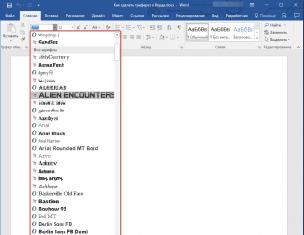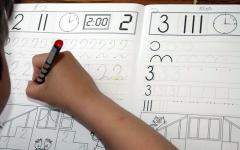The American system of school education differs from the systems in other countries. There are state public schools, private elementary schools and private secondary schools. Public schools are free and private schools are feepaying. Each state has its own system of public schools.
Elementary education begins at the age of six or seven, when a child goes to the first grade (form). At the age of sixteen schoolchildren leave the elementary school and may continue their education at one of the secondary schools or high schools, as they call them.
The programme of studies in the school includes English, Arithmetic, Geography, History of the USA, Natural Sciences and, besides, Physical Training, Singing, Drawing, Wood or Metal Work, etc. Sometimes they learn a foreign language and general history. Beside giving general education some high schools teach subjects useful to those who hope to find jobs in industry and agriculture or who want to enter colleges or universities.
After graduating from secondary schools a growing number of Americans go on to higher education. The students do not take the same courses. During the first two years they follow a basic programme. It means that every student must select at least one course from each of the basic fields of study: English, Natural Sciences, Modern Languages, History or Physical Training. After the first two years every student can select subjects according to his professional interest.
The National Government gives no direct financial aid to the institutions of higher education. Students must pay a tuition fee. This creates a financial hardship for some people. Many students have to work to pay their expenses. The Americans place a high value on education. That’s why Kennedy said, “Our progress as a nation can be no swifter than our progress in education”.
Образование в США
Американская система школьного образования отличается от систем других стран. Есть государственные общественные школы, частные начальные школы и частные средние школы. Государственные школы являются бесплатными, а частные школы - платные. Каждый штат имеет свою собственную систему общественных школ.
Начальное образование начинается в возрасте шести или семи лет, когда ребенок идет в первый класс. В возрасте шестнадцати школьники заканчивают начальную школу и могут продолжить свое образование в одной из средних школ или хай-скул, как они их называют.
Программа обучения в школе включает английский язык, арифметику, географию, историю США, естественные науки и, кроме того, физическую культуру, пение, рисование, труды и т. д. Иногда они изучают иностранный язык и общую историю. Кроме предоставления общего образования некоторые средние школы преподают предметы, полезные для тех, кто надеется найти рабочие места в промышленности и сельском хозяйстве или кто хочет пойти в колледжи или университеты.
После окончания средней школы все большее число американцев получает высшее образование. Студенты не изучают одинаковые курсы. В течение первых двух лет они следуют основной программе. Это означает, что каждый студент должен выбрать по крайней мере один курс из общих отраслей науки: английский язык, естественные науки, современные языки, история и физическая культура. После первых двух лет каждый студент может выбрать предметы в соответствии с его профессиональными интересами.
Правительство не дает прямой финансовой помощи учреждениям высшего образования. Студенты должны оплачивать обучение. Это создает финансовые трудности для некоторых людей. Многие студенты должны работать, чтобы оплатить свои расходы. Американцы придают большое значение вопросам образования. Вот почему Кеннеди сказал: "Наш прогресс как нации не может быть быстрее, чем наш прогресс в образовании".
The system of education in the USA varies greatly from state to state. School education in so called state public schools is free. Parents are free to choose any public school for their children. Although there are a lot of private schools, mainly religious, and parents have to pay for them. A school year starts in September and ends in June. It is divided into three terms or four quarters.
American children start attending elementary schools at the age of 6. They continue their studies for eight years there (8 grades). Their basic subjects in the curriculum at this stage are English, Arithmetic, Natural Science, History, Geography, Foreign Language and some others. After that pupils may enter a Senior high school or if they go to a 5- or 6-year elementary school, they then attend a 3- or 4-year Junior high school, and then enter a Senior high school. Pupils graduate from high schools at the age of 18. The high schools (also known as secondary schools) are generally larger and accommodate teenagers from four or five elementary schools. During the school year the students study four or five selective subjects according to their professional interests. They must complete a certain number of courses to receive a high school diploma or a certificate of school graduation.
In order to develop social skills and encourage students’ participation in extracurricular activities every high school has an orchestra, a music band, a choir, drama groups, football, basketball and baseball teams. School becomes the center of social life for students.
At American colleges and universities young people get higher education. They study for 4 years and get a Bachelor"s degree in arts or science. If a student wants to get a Master"s degree he must study for two more years and do a research work. Students who want to advance their education even further in a specific field can pursue a Doctor degree. The most famous American universities are Harvard, Princeton, Stanford, Yale, Columbia Universities.
Перевод
Система образования в США сильно отличается от штата к штату. Школьное образование в так называемых государственных школах является бесплатным. Родители могут свободно выбирать любую бесплатную школу для детей. Однако существует много частных школ, в основном, религиозных, и родителям нужно оплачивать обучение в них. Школьный год начинается в сентябре и заканчивается в июне. Он разделен на 3 семестра или же на 4 четверти.
Американские дети начинают посещение начальной школы в возрасте 6 лет. Они продолжают свое обучение в течение 8 лет (8 классов). Основными предметами в расписании на данном этапе считаются английский, арифметика, естествознание, история, география, иностранный язык и некоторые другие. Затем ученики могут перейти в Старшую среднюю школу или же, если они ходили в 5- или 6-летнюю начальную школу, тогда они посещают 3- или 4-летнюю Младшую среднюю школу и только затем переходят в Старшую. Учеников выпускают из средней школы в 18 лет. Средние школы, как правило, больше по размерам и вмещают в себя подростков из 4 или 5 начальных школ. В течение учебного года студенты изучают 4-5 выборочных предметов, в соответствии с их профессиональными интересами. Они обязаны пройти определенное количество курсов для того, чтобы получить диплом о среднем образовании или сертификат об окончании школы.
Для развития общественных навыков и поощрения студенческого участия во внешкольной жизни в каждой средней школе имеется оркестр, музыкальный коллектив, хор, театральная студия, команда по футболу, баскетболу и бейсболу. Школа становится центром общественной жизни для студентов.
В американских колледжах и университетах молодые люди получают высшее образование. Они обучаются в течение 4 лет и получают степень Бакалавра гуманитарных или естественных наук. Если студент намеревается получить степень Магистра, ему нужно учиться еще 2 года и провести исследовательскую работу. Студенты, желающие и далее продолжать обучение в отдельной отрасли знаний, могут получить степень Доктора. Самыми известными американскими университетами являются Гарвардский, Принстонский, Стэнфордский, Йельский и Колумбийский университеты.
Если Вам понравилось — поделитесь с друзьями :
Присоединяйтесь к нам в Facebook !
Смотрите также:
Самое необходимое из теории языка:
Предлагаем пройти тесты онлайн:
The US educational system is much decentralized and schools vary greatly from state to state. There are three levels of subsidizing of education: federal, state and local. They subsidize 3-5 per cent on a federal level, around 20 per cent on a state level and 70-80 per cent on a local level.
There are 15,000 school districts which are different in size. A school district is governed by the Board of Education/School Board/School Council which is elected every two years by the residents of the school district. Members of school boards perform their responsibilities on a volunteer basis, that means they do not get any salaries. They are to define the policies for the administration of the school district. Teachers, in turn, decide about the program and approaches of teaching.
Every resident pays a school tax to the school district he/she lives in, no matter he/she has school children or not. School education in the United States is free and parents are free to choose a school for their children. But if parents send their child to a school of another school district they have to pay the sum equivalent to the school tax directly to the school the child goes to.
There are also a lot of private schools, mainly religious, and parents have to pay for them. The cost is $ 5,000 - $ 10,000 a year.
There is no home education in the United States. Each invalid is supposed to attend school. School provides all the necessary conditions for them to study.
The school system structure in the United States looks like this. Children start going to school at the age of five. First they go to eight-year elementary school and then to high school or if they go to five- or six-year elementary school, they then attend three- or four-year middle school, and then high school. Teenagers study at high school four years and graduate from it at the age of eighteen. Members of each grade in high school have special names:
A ninth grader is called a Freshman,
- a tenth grader - a Sophomore,
- an eleventh grader - a Junior,
- a twelfth grader - a Senior.
The completion of high school is called graduation. In order to graduate, students must accumulate a certain amount of credits during their four years at school. Credits are points given for every subject that is passed successfully. In addition to that, students must successfully complete specific subjects required by the state or local educational authorities, such as US history, English, mathematics and physical education. This may vary from state to state.
Over 60% of school graduates continue their education in two- or four-year colleges or universities. At least 10% of high school students are allowed to finish school at the age of 16.
A school year starts at the beginning of September or at the end of August and ends in late June or early July, just before the Independence Day, and is divided into three terms/trimesters or four quarters. School children have winter and spring breaks for two or three weeks and summer vacation for six up to eight weeks.
There is a great variety of Saturday, Sunday, vocational and other schools. The most popular one is summer school. It is for students who want to get a deeper knowledge in a particular subject, or to skip a year, or just fail their examinations. It lasts six weeks and parents have to pay for it.
Students go to school five days a week. They get to and from school by a school bus. A typical school day in America starts at 7.30 AM with the Pledge of Allegiance in which the US flag and the whole nation is glorified. Then follows the homeroom period during which a homeroom teacher calls the roll and the principal makes his/her announcements over the intercom. Every day students usually have seven periods which last 50-55, sometimes 45 minutes. In some schools there are four periods lasting 90 minutes. There are 2-5 minute passing between periods and a break of 30 minutes for lunch.
American schools today house a large number of students but making friends can be difficult, as the same group of students does not attend all the classes. In order to encourage meeting and knowing a broader population at school, special emphasis is placed on so-called extracurricular activities where interests, rather than academic ability, bring students together.
Extracurricular activities are the many club meetings, music or drama rehearsals, and sport practice sessions that take place in American high school in the afternoon after classes. These meetings are a very important part of high school life, since they are a link between different groups of students who are placed in various academic programs. Students who usually would not meet in the classroom get to know each other in areas of common interest. They give students the opportunity to further their specific interests in various fields and to spend their free time together.
Even though they are not mandatory, many students get involved in different extracurricular activities. Since students spend a lot of time participating in various activities, school becomes the center of social life for students. They not only go to school to study the material presented in class, but they also meet together to socialize and to pursue their interests.
Other important activities in American high school are sports teams. Most schools offer a variety of teams for both boys and girls. American football, basketball and base-ball are played in the majority of schools. In addition, one may find tennis, gymnastics, hockey, swimming, golf, volleyball, cross-country, and track and field teams, depending again on the size and financial resources of the school. Soccer is also growing in popularity.
Usually schools have varsity teams, which complete with other schools and which have very intensive training, and intramural teams, which play other teams within the school itself. In most schools, there is a great deal of competition between students to join the varsity team. There often are schools regulations that make it difficult for new students to join. On the intramural teams most students are welcome to participate.
In many schools girls have fewer possibilities than boys. Smaller schools may not have some of the above-mentioned teams for girls. But a special group of girls and boys play an important part at the football and basketball games. They are called cheerleaders and they lead the crowd in cheers for their team.
In addition to clubs and sports teams, one will find the Student Council and the class officer meetings. Students are elected by their school and classmates to represent them in these bodies and to organize activities for their school.
U.S. colleges and universities offer a vide variety of programs ranging from highly academic courses to very practical ones. Students can be educated not only for academic professions, but also for technical professions, such as mechanics, nursing, medical technology, computer technology and book-keeping.
In universities young people study four years to get bachelor"s degree. If one wants to get master"s degree he/she must study two years more and do a research work. If one has master"s degree, studies more, does a research work and passes an oral, comprehensive examination he/she gets doctor"s degree (PhD).
British and American Schools
In America, all children from six to sixteen go to school. They spend
six years in “elementary” school, and four or six years in “secondary”
or “high” school. School education is free.
At the end of every school year, the children take a test. If a child
does well, he goes into next class (“grade”). If he doesn’t do well, he
has to repeat the grade.
Some schools have modern teaching equipment. like computers and closed
circuit television, but there are small country schools, with just one
classroom.
At the end of their time at school, most students get a high school
diploma. If they want to ^o on to college, they take college admission
tests.
In Britain all children from five to sixteen go to school. They spend
six years in “primary” school, and then go on to “secondary” school.
In Britain there are “state” schools, which are free, and private
schools for which parents pay, Many British private schools are
“boarding” schools. The children stay at school all the time, and only
come home in the holidays. They usually wear uniforms.
Teaching in both countries is usually quite in formal. Students often
work together in groups? and go to the teacher only when they need help.
At school pupils spend the most important of their lives. It is here
that their characters and views are formed. The word “school” always
reminds us of our childhood and youth, of close and dear people in our
life.
Перевод текста: British and American Schools
В Америке, идут в школу все дети от шесть до шестнадцать. Они проводят
шесть лет в “элементарной” школе, и четырех или шести годах во
“вторичной” или “высокой” школе. Школьное образование свободно.
В конце каждого учебного года, дети берут тест. Если ребенок
преуспевает, он входит в следующий класс (“сорт”). Если он не
преуспевает, он должен повторить сорт.
Некоторые школы имеют современное обучающее оборудование. как компьютеры
и кабельное телевидение, но есть маленькие школы страны, только с одной
классной комнатой.
В конце их времени в школе, большинство студентов получает диплом
средней школы. Если они хотят к ^o на колледже, они берут тесты входной
платы колледжа.
$a$gd‘}








